| |
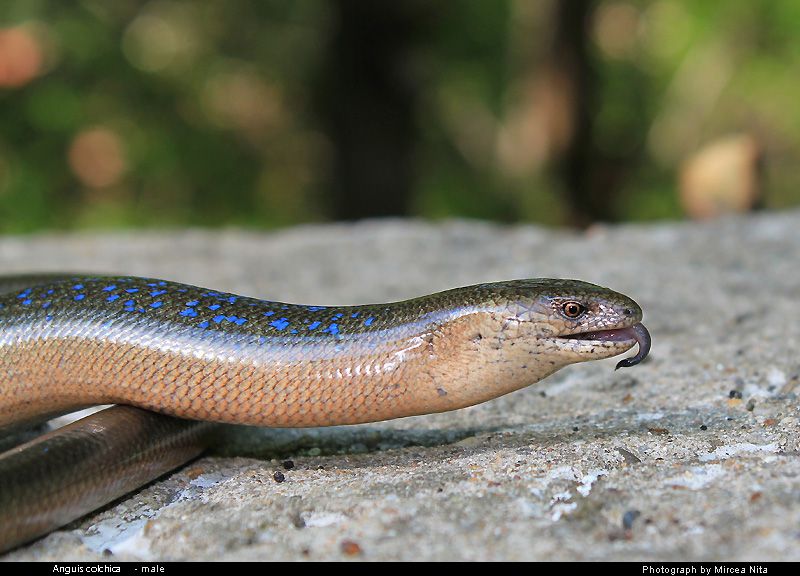
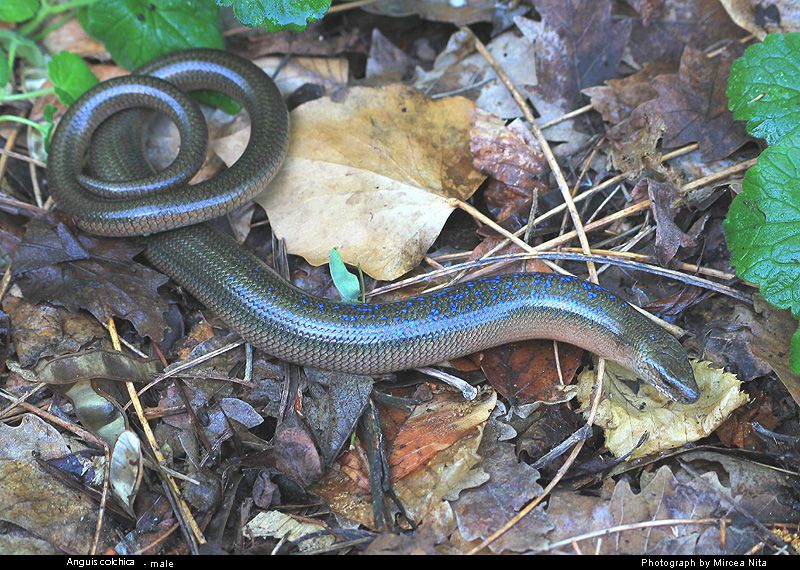
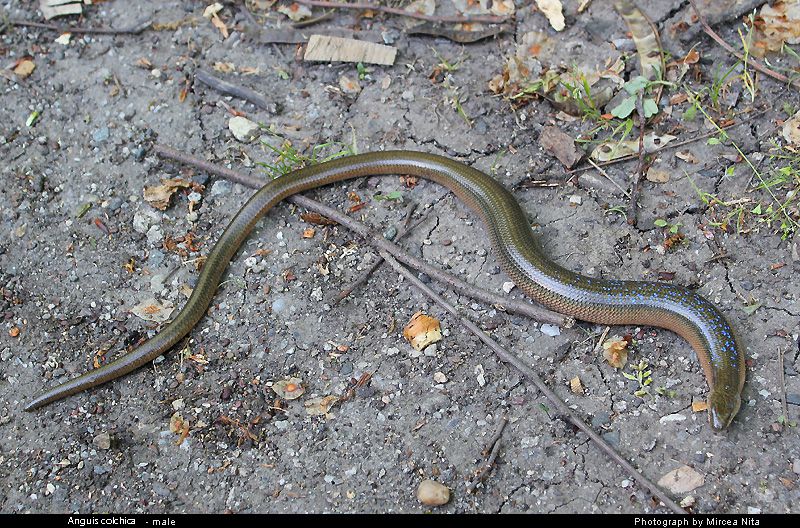
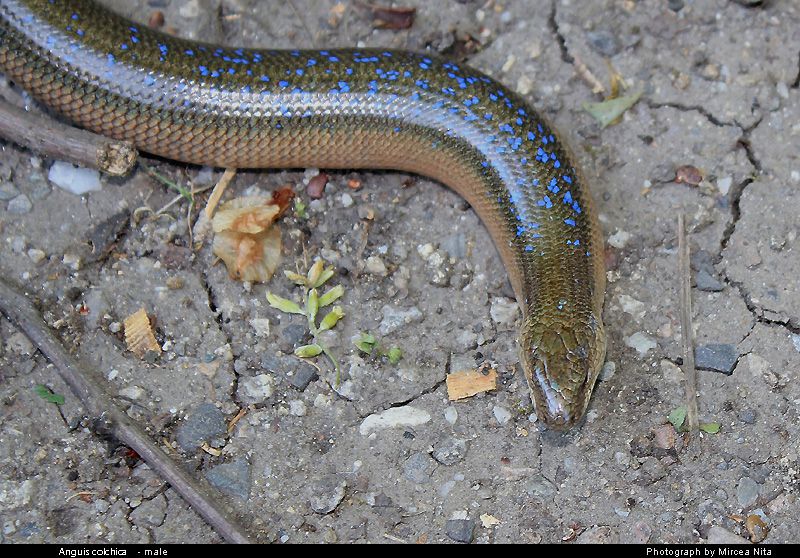
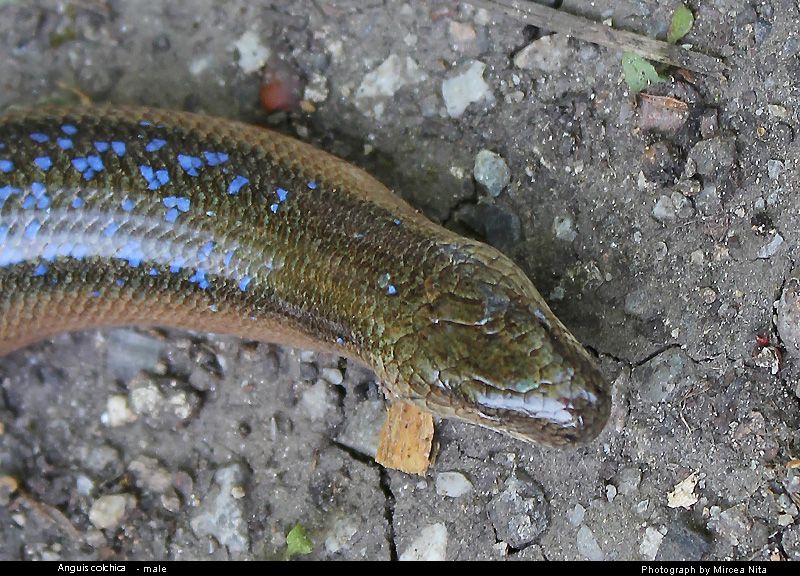
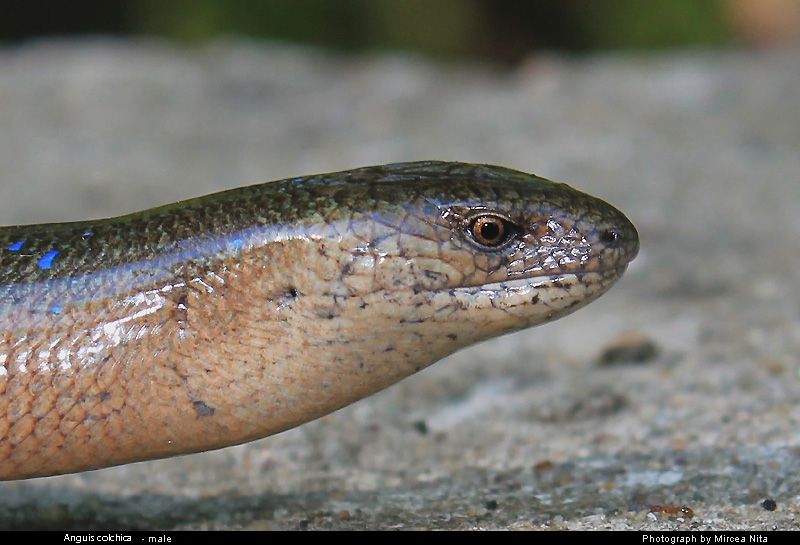
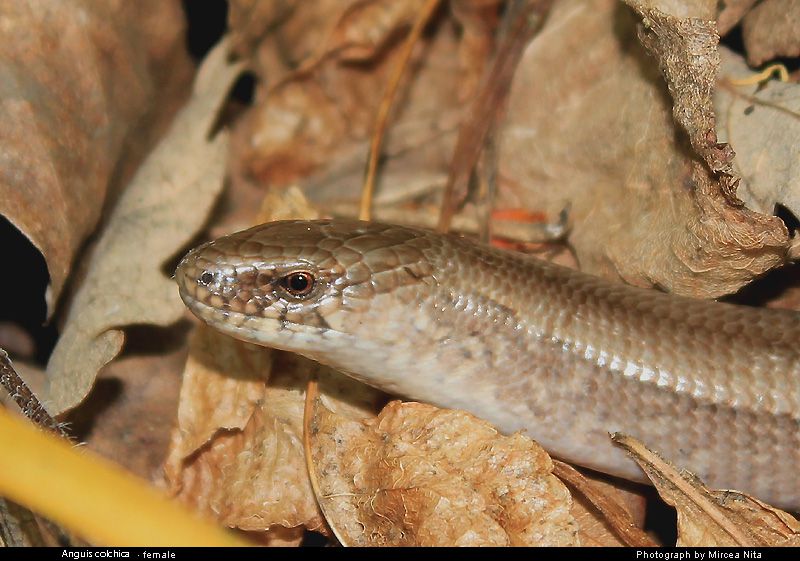
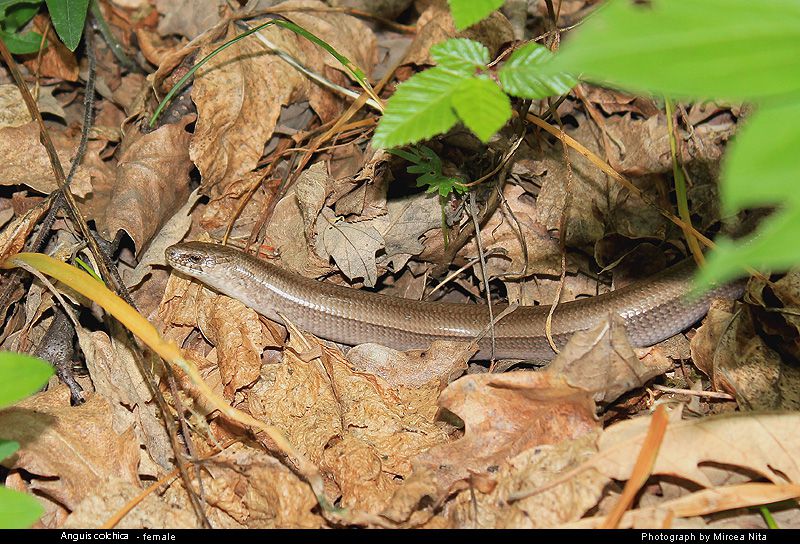
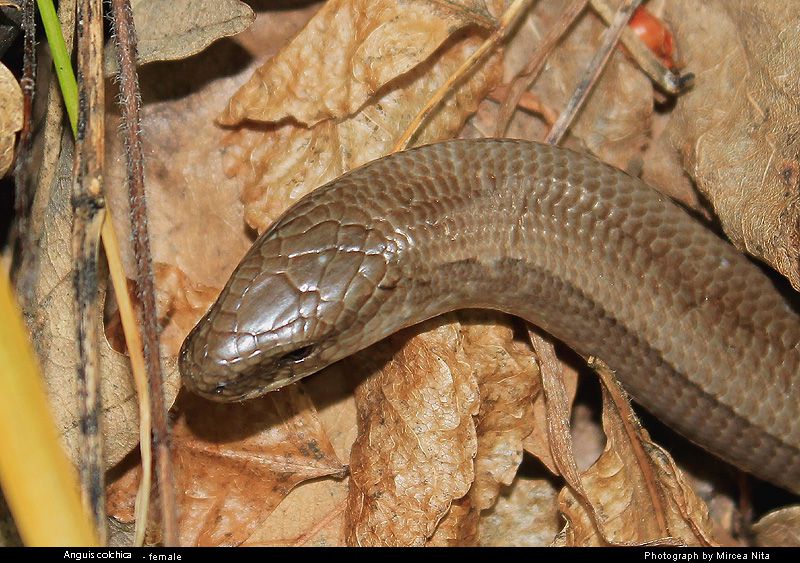
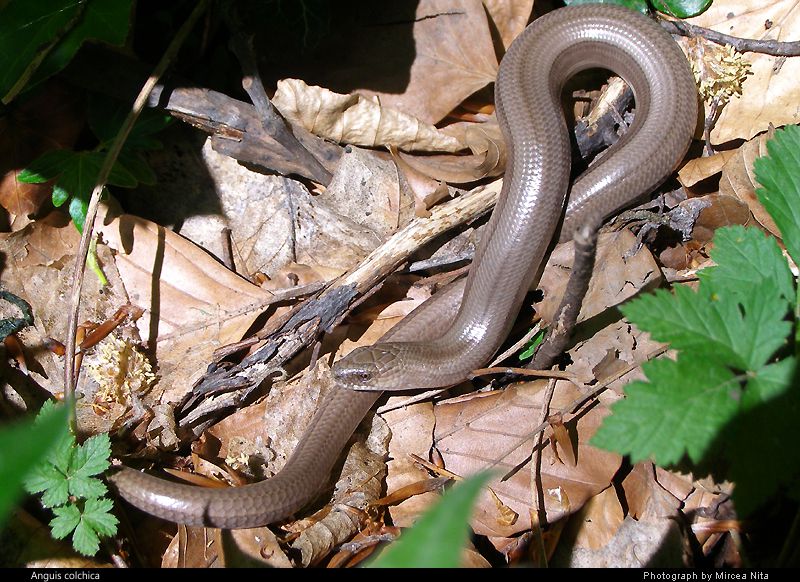
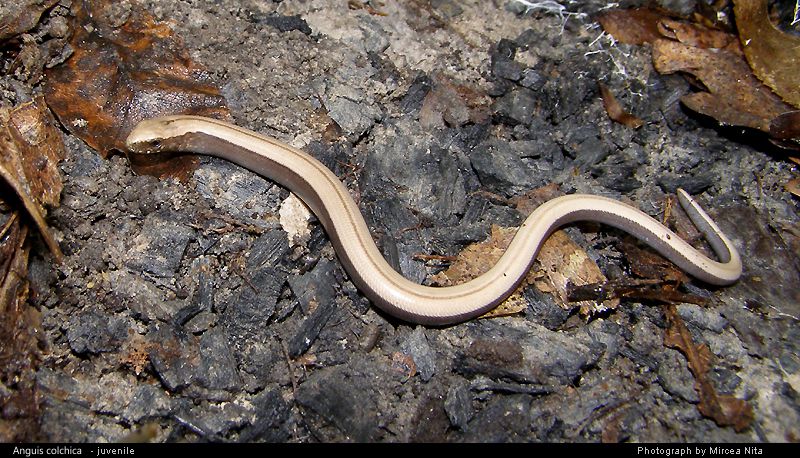
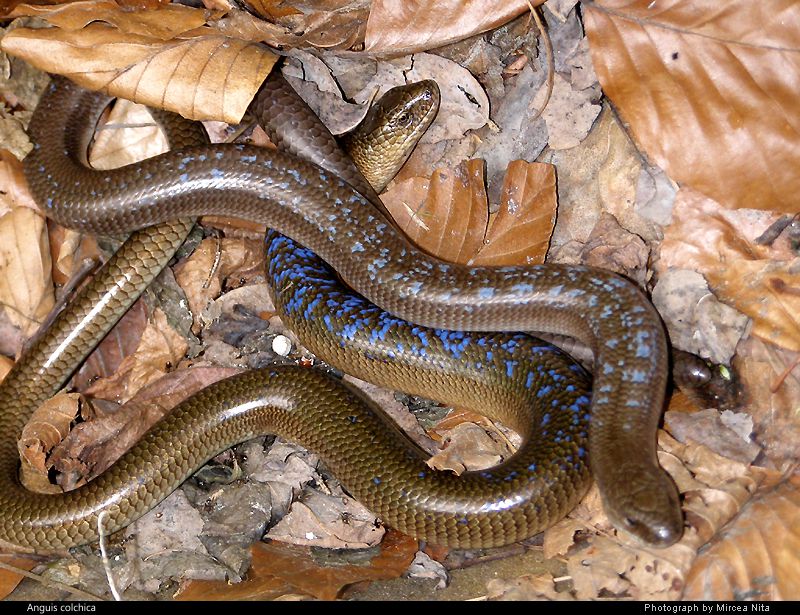
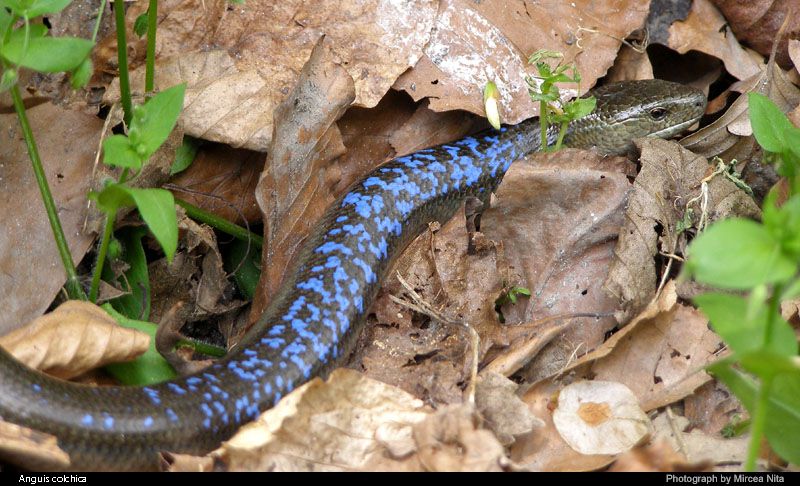
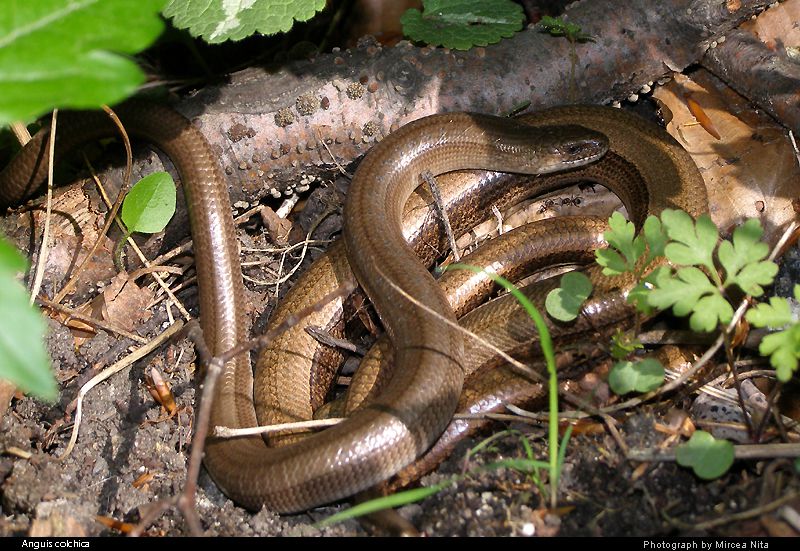
Anguis colchica
Slow worm - Anguis colchica: Linnaeus, 1758
Anguis colchica (former Anguis fragilis colchica), or slow worm, is a legless reptile native to Eurasia. External limbs are absent, and only a remnant of the pelvic girdle persists internally. Its elongated body form, combined with an absence of limbs, gives the slow worm its snakelike appearance. Unlike snakes, however, slow worms have ear openings and eyelids and their tongues are notched in the centre rather than completely forked like a snake's.
Description:
The body is covered with smooth, round and polished scales (giving a glassy appearance) and the head is quite indistinct from the body.
This species has between 24 to 26 scales around their body and it reaches about 50 cm in length. Females are brown with dark sides and a black line along the back; the ventral surface is nearly always uniform black. Males are usually uniform grey-brown with the belly mottled black or dark grey; occasionally they have very distinct blue spots. They also have proportionally larger heads.
he young of both sexes are pale golden-brown or greyish silver above, the sides and belly are pitch black. A small spot on the head leads to a continuous black stripe down the entire length of the back. It is usually only the males that loose this stripe marking as they reach sexual maturity at around 3 years.
Biology:
Slow-worms are semi-fossorial (living mostly underground, or underneath objects lying on the ground, or within vegetation litter and tussocks).
These reptiles move quite slowly, being easily caught and spend much time hiding beneath rocks and logs. Another typical feature of lizards displayed by them is the shedding of the tail when captured in order to escape predators. The tail regrows, but remains smaller. Slow-worms are mainly diurnal but have been observed foraging after dark on warm evenings.
This species withdraw for the winter in late October or early November both communally and solitarily, and sometimes share hibernating sites with other reptiles, deep in the galleries, closing the entrance with earth or moss.
Emerging from hibernation in March, the slow-worm may be seen to bask in the early morning and evening sun, as the animals come into condition for breeding, which occurs in usually in May.
This species is ovoviviparous and after mating, the female slow worm produces about 15 eggs which are incubated in her body for a few months. In late summer or early autumn the female slow worm ends up giving birth to live young which may measure around 100 mm long.
Slow worms usually feed upon earthworms, slugs, small snails and the grubs of insects.
When they are disturbed they try to move away. If caught they wriggle to escape and even bite, however it's not strong.
Within its natural environment, the slow worm is prey to numerous predators like cats, dogs, weasels and birds.
The slow worm has an interesting characteristic. The teeth are recurved, fang-like and show traces of a groove. Here are actually indications of, with time, the formation of a poisonous lizard.
These reptiles are known for their long life; usually a slow worm lives about thirty years in the wild and up to fifty-four years in captivity (this record is held by a male slow worm that lived at the Copenhagen Zoo).
Habitat:
The slow worm inhabits warm, moist and shaded areas across the European continent and is also commonly found in gardens, as well as meadows and farmland. In all habitats, slow-worms require dense vegetation, especially grasses coupled with sunny areas to allow thermoregulation and, preferably, loose soil into which to burrow. Very wet and very dry habitats are usually avoided.
It likes warmth but instead of basking in the open sun it prefers to hide under a stone, log or piece of discarded rubbish such as a sheet of corrugated iron or plank of wood exposed to the sun. Slow worms are also keen on compost heaps where they find warmth and plenty of food.
Distribution:
This species is widely distributed from Great Britain and Europe eastward to the Urals and Caspian Sea under 2000 m altitude.
Range: Finland, Norway, Sweden, England (incl. Channel islands Guernsey, Herm, Jethou, Jersey), Denmark, Germany, Austria, Switzerland, Belgium, Luxemburg, Netherlands, Portugal, Spain, France, Italy, Czech Republic, Slovakia, Hungary, Albania, Bulgaria, Greece (incl. Corfu), Croatia, Slovenia, Bosnia and Herzegovina, Monte Negro, Macedonia, Serbia, Poland, Romania, Turkey (from Trabzon, Hopa) [Clark & Clark 1973], former Soviet Union: Russia, Belarus, Georgia, Ukraine, Moldova, Lithuania, Latvia, Estonia, Caucasus, Asia Minor, North of Iran
Scientific name: Anguis colchica (former Anguis fragilis colchica)
Common name: slow worm
Taxonomy:
Species: Anguis colchica
IUCN Status: LC (Least Concern - 2009 - needs updating)
This species is listed as Least Concern in view of its wide distribution, presumed large population and broad range of habitats.
The slow-worm, like all species, it has suffered declines in recent decades due to loss of suitable habitat.
References:
Arnold, E. N., and J. A. Burton. 1978: A Field Guide to the Reptiles and Amphibians of Britain and Europe. Collins, London;
Baran, I., Kasparek, M., & Oz, M. 1988. On the distribution of the slow worm, Anguis fragilis, and the European glass lizard, Ophisaurus apodus, in Turkey Zoology in the Middle East 2;
Boulenger, G.A. 1885. Catalogue of the lizards in the British Museum (Natural History). Vol. 2, Second edition. London;
Fry, B. et al. (February 2006). "Early evolution of the venom system in lizards and snakes". Nature 439(7076);
Fuhn, I. & S. Vancea, 1961: Fauna Republicii Române, 14. Reptilia (Testoase, Sopârle, Serpi). Bucuresti;
Gasc, J.-P., A. Cabela, J. Crnobrnja-Isailovic, D. Dolmen, K. Grossenbacher, P. Haffner, J. Lescure, H. Martens, J.P. Martinez-Rica, H. Maurin, M.E. Oliveira, T.S. Sofianidou, M. Veith & A. Zuiderwijk, 1997: Atlas of Amphibians and Reptiles in Europe. - Societas Europaea Herpetologica und Muséum National d'Historie Naturelle (IEGB/SPN), Paris;
Gvodík, Václav; David Jandzik, Petros Lymberakis, Daniel Jablonski, Ji?í Moravec, 2010. Slow worm, Anguis fragilis (Reptilia: Anguidae) as a species complex: Genetic structure reveals deep divergences. Molecular Phylogenetics and Evolution 55 (2);
Joger, U. & N. Stümpel, 2005: Handbuch der Reptilien und Amphibien Europas, Wiebelsheim;
Sos, T. 2008. Review of recent taxonomic and nomenclatural changes in European Amphibia and Reptilia related to Romanian herpetofauna. Herpetologica Romanica 2;
Szczerbak, N.N. 2003. Guide to the Reptiles of the Eastern Palearctic. Krieger, Malabar, FL
|
|

